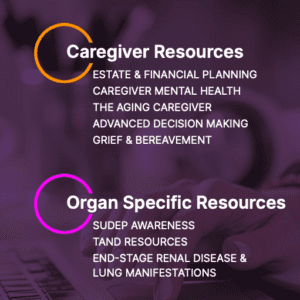In Part 1 of “The TSC Navigator: A New Resource to Guide Families through the TSC Journey,” I sat down with Ashley Pounders to discuss the TSC Navigator, its purpose, and how the TSC Alliance hopes to help those affected by tuberous sclerosis complex (TSC). Now, in part 2, we dive deeper into the categories offered, giving patients the right information at the right time, and the future of the TSC Navigator.
TSC Navigator Categories
Currently, the TSC Navigator offers five “broad categories:”
- Beginning Your Journey
- For those at the start of their TSC journey, this section provides an overview of what TSC is, as well as tips and options for what to do following a diagnosis.
- Medical Challenges
- The “Medical Challenges” section offers more insight into coordination of care, pharmacy types, medication access issues, and pharmacy resources.
- Stories of Hope
- This section provides stories and lived experiences of people with TSC from infancy into adulthood.
- Support Navigators
- The TSC Alliance currently offers three support navigators (including Ashley!) to discuss treatment options, provide emotional support, help find specialists, or answer any questions.
- Resources
- In the fifth section, you can find supportive resources, caregiver resources, organ-specific resources, and information on work, school, and housing.

To develop these categories, Ashley says:
A huge part was listening to the TSC community and taking into account their whole journey. We also thought about what we have seen and heard over the years. Even though our website is amazing and has so much content, there is some information that might not be what you want or where you are. Our core through this entire process was wanting to be sensitive and relatable.
The layout of the TSC Navigator also offers those with TSC, caregivers, and their families a better sense of control. Spending time in the doctor’s office, or in the hospital, can be extremely lonely and isolating. Ashley explains:
We wanted the Navigator to really reflect the rawness in this process. Through this tool, we want users to feel like they have a sense of control back — getting to see what they want to see, and how much they want to see, when they want to see it. For example, since TSC is a genetic disorder, not everyone starts the journey in infancy and childhood. So ‘Beginning the Journey’ reflects that each journey is unique. This same section has manifestations and ideas for prenatal, infant, and adult diagnoses.
The Right Information at the Right Time
She continues by explaining that these separations are very necessary for a more personalized patient experience. For example, if an adult has kidney bleeding, they don’t really need to know about infantile spasms. The TSC Navigator allows for an effective breakdown—offering the right content for the right person at the right time.
One way to ensure that this happens is through content control measures within the TSC Navigator. Ashley explains:
Because these topics can be very sensitive and hard-to-digest, we embedded them in a PDF. So it won’t be like anyone can accidentally hit a link and come face-to-face with information that you’re not ready for yet. You can print it or share it. I’ve heard from the community that sometimes it is so much more helpful to just print something and have it in their hand.
For example, “Resources” offers some topics and information that, while profoundly helpful, can be hard to think about. What does a caregiver do if their child is admitted to an adult hospital, non-verbal, in pain, and dealing with COVID-19 restrictions? What are the differences between palliative care and hospice care? What could put families at a higher risk of fatal outcomes? How should and can caregivers address SUDEP awareness? According to Ashley:
Less than 30% of all neurologists talk about SUDEP. What we as providers are not willing to speak of, parents question: does silence mean we don’t have to worry? Does it make me a bad parent? This lack of communication only furthers fear in parents’ and families’ minds. These are realities and we need to talk about it so the first time you hear about it isn’t in a crisis.
The TSC Navigator also aims to provide information to those who have experienced grief and bereavement and to help them as they grapple with this altogether unfamiliar terrain. Ashley says:
We want to support those who are understanding what their journey looks like now that their time as a caregiver has changed. I don’t say ended, because you’re always a caregiver. Just because your loved one is no longer here doesn’t mean that your relationship with us has changed. How can we make sure that part of the journey, as painful as it is, has us extending our hand to them and that their part of the journey still matters?
By focusing on actionable, timely, and compassionate care, the TSC Navigator offers an invaluable resource for patients and their loved ones.

The Future of TSC Navigator
Within two weeks of launching, the TSC Navigator has seen an immense response from the community. At first, the TSC Alliance hoped that the tool would draw in 1,000 people by the end of the year; they reached this goal within the first few hours, highlighting the importance of this resource.
In the future, the TSC Alliance also hopes to expand the categories, with the TSC Navigator becoming an evolving platform. While “Beginning Your Journey” probably will not change that much, the TSC Alliance hopes to add additional resources to help patients through their entire lives. For example, shares Ashley:
One thing we would love to focus on is the pediatric-to-adult transition of care. How do we bridge that gap and what does that mean in life? Many people underestimate the care model from pediatric to adult and it can be difficult for families with special needs. We want to help them better navigate that journey.
Another important topic, and one that is necessary to consider, is that of the aging caregiver. In addition to estate and financial planning, many caregivers grapple with questions such as, “What are the steps I need to take care of my loved one? What is going to happen to my loved one when I’m not there?” These are isolating concerns and, sometimes, caregivers are unsure how to bring these up in clinic appointments. While the TSC Navigator does have options for the aging caregiver, improving caregiver mental health will be a big focus moving forward. Ashley says:
Caregivers are human too. This whole platform is not just for those who have the actual diagnosis, but for everyone affected. The family dynamic is so important. We want caregivers thinking about their care as well. TSC Navigator offers a well-thought-out plan to help them articulate their thoughts in the middle of a crisis situation.
The TSC Alliance also welcomes and actively encourages feedback from the community, so feel free to reach out with any thoughts on the TSC Navigator! Overall, the TSC Alliance shares:
The Navigator exists because we have the bravery and communication from our community. We are so grateful for those who are willing to share their personal journey with us so that we can improve this process for all affected.
Learn more about the TSC Navigator.
“This week, Dec. 1-7, marks Infantile Spasm Awareness Week. Infantile spasms are often a key indicator for tuberous sclerosis complex (TSC) in infants. For anyone wanting to learn more about this symptom – or other symptoms that are typical for TSC – visit tscalliance.org.”


